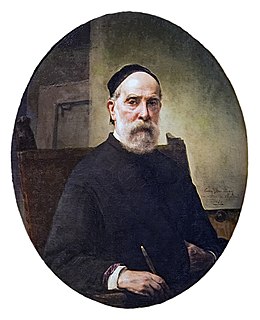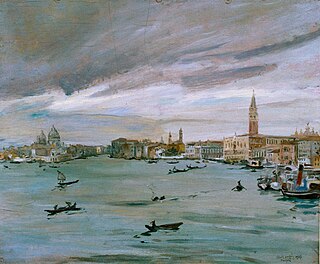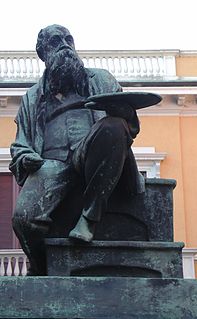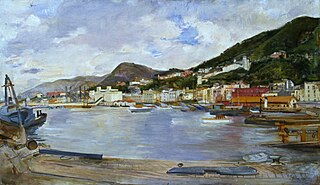
Emilio Gola (1851–1923) was an Italian painter.

Emilio Gola (1851–1923) was an Italian painter.
Born in Milan into a noble family, Gola was encouraged to develop his interest in art in his adolescence by his father, a dilettante painter. He graduated in industrial engineering from the Milan Polytechnic in 1873 and devoted himself to painting under the guidance of Sebastiano De Albertis. His training also involved frequent trips to Paris and the Netherlands.
He made his debut at the 1879 Exposition of Fine Arts at the Brera Academy and afterwards participated regularly in national exhibitions, but obtained his greatest official recognition at the European level. By the 1880s he was an esteemed portrait who depicted women of the Milanese nobility in their fashionable, worldly dimension but with a vigorously naturalistic approach. His portraits were accompanied by a rich repertoire of views of Milan and the countryside of Brianza in bright colours that were to constitute his stylistic hallmark. Active in the region of Liguria and Venice, he focused in his late period on seascapes distinguished by great formal synthesis and expressive intensity. One of his pupils was Alberto Malaspina (painter) (1853–1903). [1]

Francesco Hayez was an Italian painter. He is considered one of the leading artists of Romanticism in mid-19th-century Milan, and is renowned for his grand historical paintings, political allegories, and portraits.

Aldo Carpi was an Italian artist, painter and writer, author of a collection of memoirs concerning his imprisonment in the infamous Mauthausen-Gusen concentration camp.

Giovanni Ambrogio de Predis was an Italian Renaissance painter, illuminator and designer of coins active in Milan. Ambrogio gained a reputation as a portraitist, including as a painter of miniatures, at the court of Ludovico Sforza.

Carlo Francesco Nuvolone was an Italian painter of religious subjects and portraits who was active mainly in Lombardy. He became the leading painter in Lombardy in the mid-17th century, producing works on canvas as well as frescoes. Because his style was perceived as close to that of Guido Reni he was nicknamed il Guido della Lombardia.

Emilio Longoni was an Italian painter.

Contardo Barbieri was an Italian painter.

Emilio Sommariva was an Italian painter and photographer.

Giovanni (Gianni) Maimeri was an Italian painter.

Mosè Bianchi (1840–1904) was an Italian painter and printmaker.

Achille Cattaneo was an Italian painter.

Sebastiano De Albertis was an Italian painter.

Donato Frisia (1883–1953) was an Italian painter.

Achille Funi was an Italian painter who painted in a neoclassical style.

Emilio Magistretti was an Italian painter.

Giovanni Sottocornola (1855–1917) was an Italian painter.
Arte Informale is a term coined in 1950 by the French critic Michel Tapié to refer to the art movement that began during the mid-1940s in post-World War II Europe. This movement also paralleled the Abstract Expressionism movement that was taking place at the same time in the United States, and had ties to the Arte Povera movement. Sometimes referred to as Tachism, Art Autre or Lyrical Abstraction, it was a type of abstraction in which form became less important than that of the expressive impulses of the artist, and was opposed to the rationalism of traditional abstraction. The qualities of informal art explore the possibilities of gesture, materials, and signage as the basis of communication. Oftentimes art characterized as informal is executed spontaneously and the approach to painting and sculpture are generally gestural, performative, expressionistic and experimental. Certain artists such as Lucio Fontana, Alberto Burri and Emilio Vedova were crucial figures of this movement.

Attilio Pusterla was an Italian painter.

Pietro Morgari was an Italian painter, primarily of portraits.
Alberto Malaspina was an Italian painter, depicting landscapes and seascapes.
Piero Marussig was an Italian painter.
![]() Media related to Emilio Gola at Wikimedia Commons
Media related to Emilio Gola at Wikimedia Commons